BoatNews.com

How to distinguish a ketch, a yawl or a schooner?
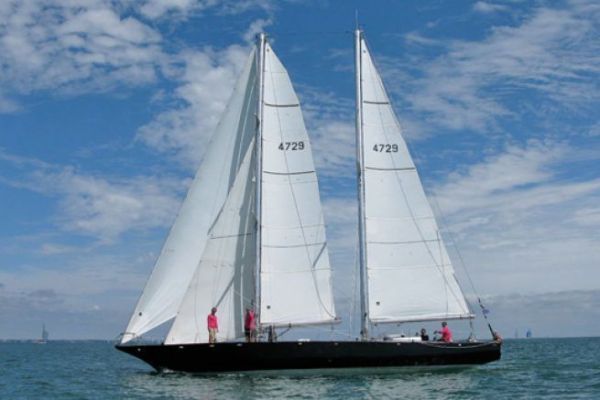
If for you all the sailing boats merge, here is how to differentiate those which are rigged with 2 masts. To help you classify the types of yachts, here is a series entitled"Learn to recognize them". Today, the differences between a ketch, a yawl and a schooner.
Sailing boats with two masts are classified in 3 categories: the ketch , the yawl and the schooner .
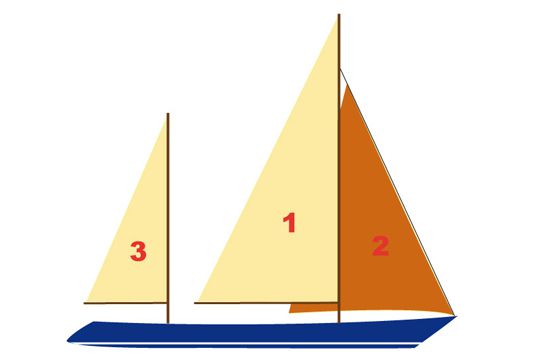
Ketch : - 1 mainsail - 2 jib or genoa - 3 mizzen
A ketch has the mizzen mast (at the stern) smaller than the main mast (called mainmast). To be a ketch , the mizzen mast must be placed forward of the helm, or more precisely of the rudder. If the mizzen mast is aft, we are dealing with a yawl (see below).
A ketch always has a mainsail without a jib. A ketch that rigs a jib (triangular sail above) the jib is a Dundee.
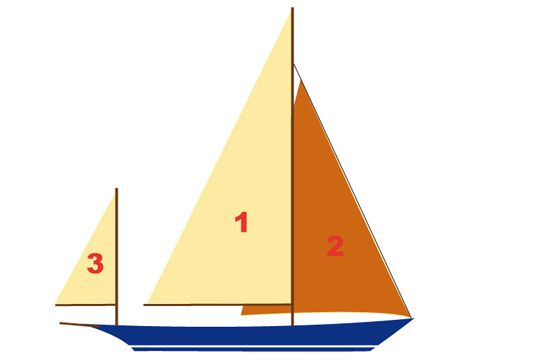
Yawl : - 1 mainsail - 2 jibs or genoa - 3 tapes
The yawl has the same rigging as the ketch , but the mizzen is called here a tape-cul and it is placed behind the rudder. Often small, it is not used to propel the boat , but to balance the yacht according to the conditions.
Placed far back on the boat , it often requires a mallet tail (a kind of bowsprit towards the back) to carry its sheet. It can be fitted with an under-bar for its rigidity.
The schooner
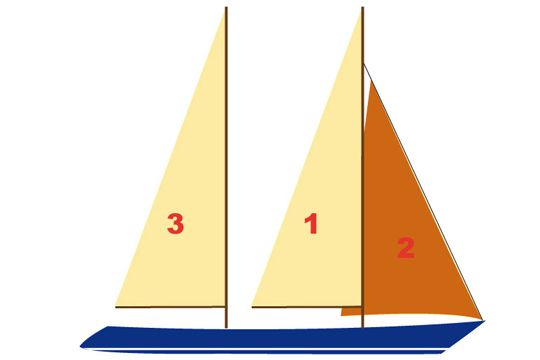
Schooner (masts of identical heights) : - 1 foresail - 2 jib or genoa - 3 mainsail
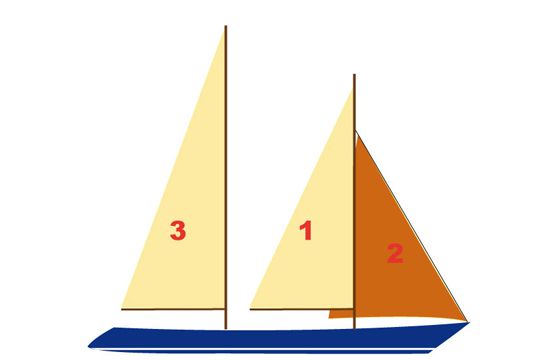
Goelette (foremast smaller than the mainmast) : - 1 foresail - 2 jib or genoa - 3 mainsail
The schooner has at least 2 masts, but can carry more. The masts are either identical in size, or the foremast (foremast) is smaller than the main mast. There are many forms of sail on schooners that the foresail rigged as a mainsail (on a boom) or as a jib with the halyard point on the main mast.
Among the known examples of ketch we can quote Pen Duick VI with which Tarbaly won the solo transatlantic race or Joshua with which Moitessier made his famous round-the-world trip
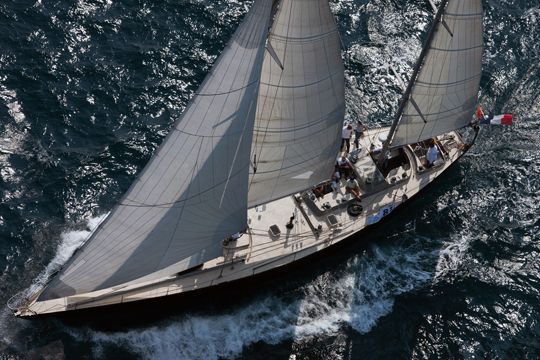
Typical of the yawl , the boat designed by Harlé for Van Den Heede with which he finished 3rd in his first Vendée Globle.

The exploration boats Tara and Why are schooners with a main mast as high as the foremast.

Guide to Understanding Sail Rig Types (with Pictures)
There are a lot of different sail rig types and it can be difficult to remember what's what. So I've come up with a system. Let me explain it in this article.
What are the different types of sail rig? The sail rig is determined by the number of masts and the layout and shape of sails. Most modern ships are fore-and-aft rigged, while old ships are square-rigged. Rigs with one mast are sloops and cutters. Ketches, yawls, brigs, and schooners have two masts. Barques have three masts. Rigs can contain up to seven masts.
'Yeah, that's a gaff brig, and that a Bermuda cutter' - If you don't know what this means (neither did I) and want to know what to call a two-masted ship with a square-rigged mainsail, this article is definitely for you.
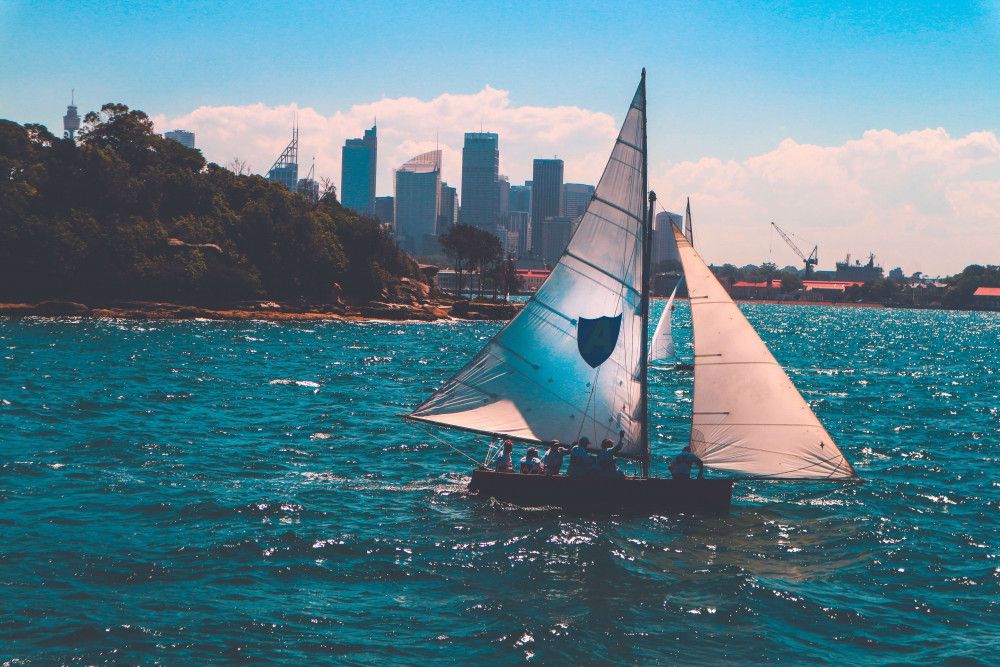
On this page:
More info on sail rig types, mast configurations and rig types, rigs with one mast, rigs with two masts, rigs with three masts, related questions.
This article is part 2 of my series on sails and rig types. Part 1 is all about the different types of sails. If you want to know everything there is to know about sails once and for all, I really recommend you read it. It gives a good overview of sail types and is easy to understand.

The Ultimate Guide to Sail Types and Rigs (with Pictures)
First of all, what is a sail rig? A sail rig is the way in which the sails are attached to the mast(s). In other words, it's the setup or configuration of the sailboat. The rig consists of the sail and mast hardware. The sail rig and sail type are both part of the sail plan. We usually use the sail rig type to refer to the type of boat.
Let's start by taking a look at the most commonly used modern sail rigs. Don't worry if you don't exactly understand what's going on. At the end of this article, you'll understand everything about rig types.
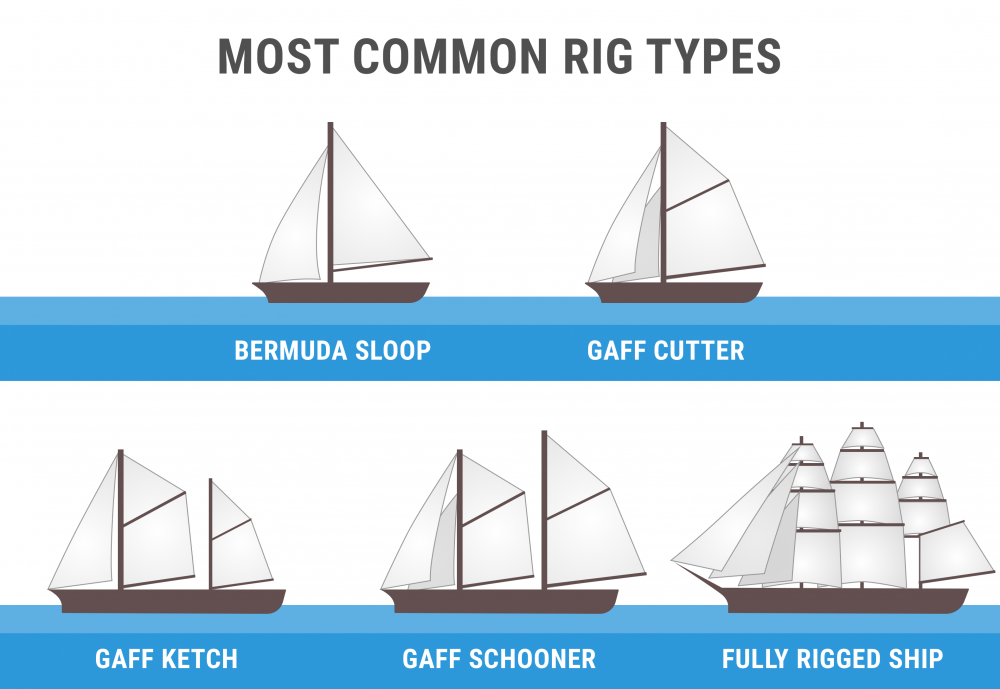
The sail rig and sail plan are often used interchangeably. When we talk of the sail rig we usually mean the sail plan . Although they are not quite the same. A sail plan is the set of drawings by the naval architect that shows the different combinations of sails and how they are set up for different weather conditions. For example a light air sail plan, storm sail plan, and the working sail plan (which is used most of the time).
So let's take a look at the three things that make up the sail plan.
The 3 things that make up the sail plan
I want to do a quick recap of my previous article. A sail plan is made up of:
- Mast configuration - refers to the number of masts and where they are placed
- Sail type - refers to the sail shape and functionality
- Rig type - refers to the way these sails are set up on your boat
I'll explore the most common rig types in detail later in this post. I've also added pictures to learn to recognize them more easily. ( Click here to skip to the section with pictures ).
How to recognize the sail plan?
So how do you know what kind of boat you're dealing with? If you want to determine what the rig type of a boat is, you need to look at these three things:
- Check the number of masts, and how they are set up.
- You look at the type of sails used (the shape of the sails, how many there are, and what functionality they have).
- And you have to determine the rig type, which means the way the sails are set up.
Below I'll explain each of these factors in more detail.
The most common rig types on sailboats
To give you an idea of the most-used sail rigs, I'll quickly summarize some sail plans below and mention the three things that make up their sail plan.
- Bermuda sloop - one mast, one mainsail, one headsail, fore-and-aft rigged
- Gaff cutter - one mast, one mainsail, two staysails, fore-and-aft rigged
- Gaff schooner - two-masted (foremast), two mainsails, staysails, fore-and-aft rigged
- Gaff ketch - two-masted (mizzen), two mainsails, staysails, fore-and-aft rigged
- Full-rigged ship or tall ship - three or more masts, mainsail on each mast, staysails, square-rigged
The first word is the shape and rigging of the mainsail. So this is the way the sail is attached to the mast. I'll go into this later on. The second word refers to the mast setup and amount of sails used.
Most sailboats are Bermuda sloops. Gaff-rigged sails are mostly found on older, classic boats. Square-rigged sails are generally not used anymore.
But first I want to discuss the three factors that make up the sail plan in more detail.
Ways to rig sails
There are basically two ways to rig sails:
- From side to side, called Square-rigged sails - the classic pirate sails
- From front to back, called Fore-and-aft rigged sails - the modern sail rig
Almost all boats are fore-and-aft rigged nowadays.
Square sails are good for running downwind, but they're pretty useless when you're on an upwind tack. These sails were used on Viking longships, for example. Their boats were quicker downwind than the boats with fore-and-aft rigged sails, but they didn't handle as well.
The Arabs first used fore-and-aft rigged sails, making them quicker in difficult wind conditions.
Quick recap from part 1: the reason most boats are fore-and-aft rigged today is the increased maneuverability of this configuration. A square-rigged ship is only good for downwind runs, but a fore-and-aft rigged ship can sail close to the wind, using the lift to move forward.
The way the sails are attached to the mast determines the shape of the sail. The square-rigged sails are always attached the same way to the mast. The fore-and-aft rig, however, has a lot of variations.
The three main sail rigs are:
- Bermuda rig - most used - has a three-sided (triangular) mainsail
- Gaff rig - has a four-sided mainsail, the head of the mainsail is guided by a gaff
- Lateen rig - has a three-sided (triangular) mainsail on a long yard
The Bermuda is the most used, the gaff is a bit old-fashioned, and the lateen rig is outdated (about a thousand years). Lateen rigs were used by the Moors. The Bermuda rig is actually based on the Lateen rig (the Dutch got inspired by the Moors).
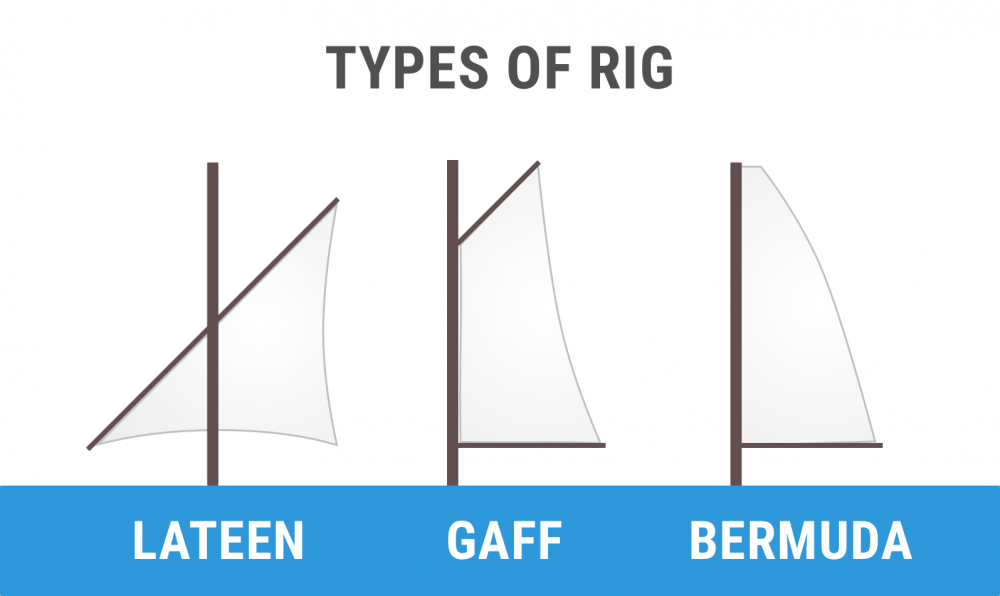
Other rig types that are not very common anymore are:
- Junk rig - has horizontal battens to control the sail
- Settee rig - Lateen with the front corner cut off
- Crabclaw rig
Mast configuration
Okay, we know the shape of the mainsail. Now it's time to take a look at the mast configuration. The first thing is the number of masts:
- one-masted boats
- two-masted boats
- three-masted boats
- four masts or up
- full or ship-rigged boats - also called 'ships' or 'tall ships'
I've briefly mentioned the one and two mast configurations in part 1 of this article. In this part, I'll also go over the three-masted configurations, and the tall ships as well.
A boat with one mast has a straightforward configuration because there's just one mast. You can choose to carry more sails or less, but that's about it.
A boat with two masts or more gets interesting. When you add a mast, it means you have to decide where to put the extra mast: in front, or in back of the mainmast. You can also choose whether or not the extra mast will carry an extra mainsail. The placement and size of the extra mast are important in determining what kind of boat we're dealing with. So you start by locating the largest mast, which is always the mainmast.
From front to back: the first mast is called the foremast. The middle mast is called the mainmast. And the rear mast is called the mizzenmast.
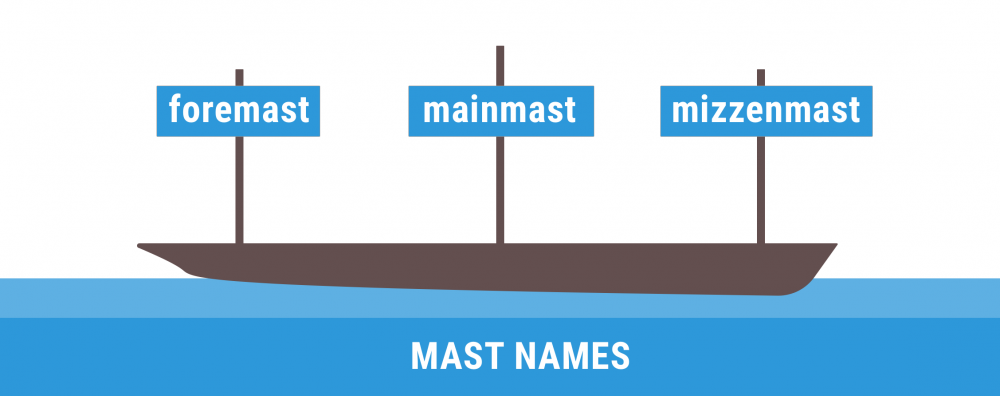
What is the mizzenmast? The mizzenmast is the aft-most (rear) mast on a sailboat with three or more masts or the mast behind the mainmast on a boat with two masts. The mizzenmast carries the mizzen sail. On a two-masted boat, the mizzenmast is always (slightly) smaller than the mainmast. What is the purpose of the mizzen sail? The mizzen sail provides more sail area and flexibility in sail plan. It can be used as a big wind rudder, helping the sailor to have more control over the stern of the ship. It pushes the stern away from the wind and forces the bow in the opposite way. This may help to bring the bow into the wind when at anchor.
I always look at the number of masts first, because this is the easiest to spot. So to make this stuff more easy to understand, I've divided up the rig types based on the number of masts below.
Why would you want more masts and sail anyways?
Good question. The biggest advantage of two masts compared to one (let's say a ketch compared to a sloop), is that it allows you to use multiple smaller sails to get the same sail area. It also allows for shorter masts.
This means you reduce the stress on the rigging and the masts, which makes the ketch rig safer and less prone to wear and tear. It also doesn't capsize as quickly. So there are a couple of real advantages of a ketch rig over a sloop rig.
In the case of one mast, we look at the number of sails it carries.
Boats with one mast can have either one sail, two sails, or three or more sails.
Most single-masted boats are sloops, which means one mast with two sails (mainsail + headsail). The extra sail increases maneuverability. The mainsail gives you control over the stern, while the headsail gives you control over the bow.
Sailor tip: you steer a boat using its sails, not using its rudder.
The one-masted rigs are:
- Cat - one mast, one sail
- Sloop - one mast, two sails
- Cutter - one mast, three or more sails
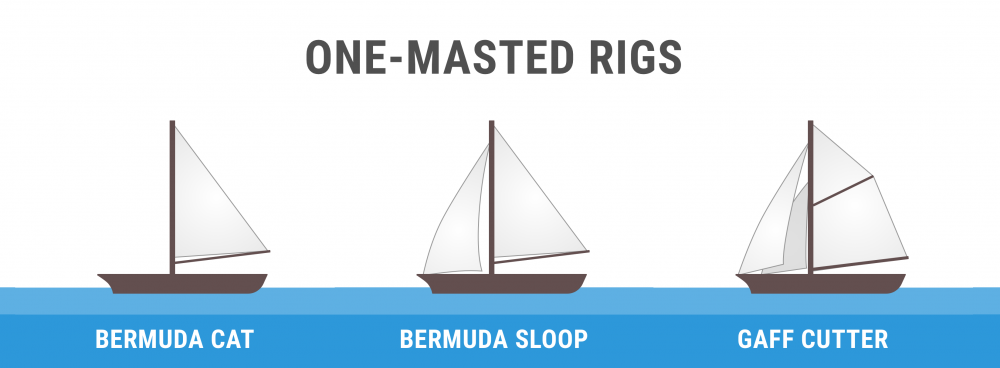
The cat is the simplest sail plan and has one mast with one sail. It's easy to handle alone, so it's very popular as a fishing boat. Most (very) small sailboats are catboats, like the Sunfish, and many Laser varieties. But it has a limited sail area and doesn't give you the control and options you have with more sails.
The most common sail plan is the sloop. It has one mast and two sails: the main and headsail. Most sloops have a Bermuda mainsail. It's one of the best racing rigs because it's able to sail very close to the wind (also called 'weatherly'). It's one of the fastest rig types for upwind sailing.
It's a simple sail plan that allows for high performance, and you can sail it short-handed. That's why most sailboats you see today are (Bermuda) sloops.
This rig is also called the Marconi rig, and it was developed by a Dutch Bermudian (or a Bermudian Dutchman) - someone from Holland who lived on Bermuda.
A cutter has three or more sails. Usually, the sail plan looks a lot like the sloop, but it has three headsails instead of one. Naval cutters can carry up to 6 sails.
Cutters have larger sail area, so they are better in light air. The partition of the sail area into more smaller sails give you more control in heavier winds as well. Cutters are considered better for bluewater sailing than sloops (although sloops will do fine also). But the additional sails just give you a bit more to play with.
Two-masted boats can have an extra mast in front or behind the mainmast. If the extra mast is behind (aft of) the mainmast, it's called a mizzenmast . If it's in front of the mainmast, it's called a foremast .
If you look at a boat with two masts and it has a foremast, it's most likely either a schooner or a brig. It's easy to recognize a foremast: the foremast is smaller than the aft mast.
If the aft mast is smaller than the front mast, it is a sail plan with a mizzenmast. That means the extra mast has been placed at the back of the boat. In this case, the front mast isn't the foremast, but the mainmast. Boats with two masts that have a mizzenmast are most likely a yawl or ketch.
The two-masted rigs are:
- Lugger - two masts (mizzen), with lugsail (a cross between gaff rig and lateen rig) on both masts
- Yawl - two masts (mizzen), fore-and-aft rigged on both masts. Main mast is much taller than mizzen. Mizzen without a mainsail.
- Ketch - two masts (mizzen), fore-and-aft rigged on both masts. Main mast with only slightly smaller mizzen. Mizzen has mainsail.
- Schooner - two masts (foremast), generally gaff rig on both masts. Main mast with only slightly smaller foremast. Sometimes build with three masts, up to seven in the age of sail.
- Bilander - two masts (foremast). Has a lateen-rigged mainsail and square-rigged sails on the foremast and topsails.
- Brig - two masts (foremast), partially square-rigged. The main mast carries small lateen-rigged sail.

The yawl has two masts that are fore-and-aft rigged and a mizzenmast. The mizzenmast is much shorter than the mainmast, and it doesn't carry a mainsail. The mizzenmast is located aft of the rudder and is mainly used to increase helm balance.
A ketch has two masts that are fore-and-aft rigged. The extra mast is a mizzenmast. It's nearly as tall as the mainmast and carries a mainsail. Usually, the mainsails of the ketch are gaff-rigged, but there are Bermuda-rigged ketches too. The mizzenmast is located in front of the rudder instead of aft, as on the yawl.
The function of the ketch's mizzen sail is different from that of the yawl. It's actually used to drive the boat forward, and the mizzen sail, together with the headsail, are sufficient to sail the ketch. The mizzen sail on a yawl can't really drive the boat forward.
Schooners have two masts that are fore-and-aft rigged. The extra mast is a foremast which is generally smaller than the mainmast, but it does carry a mainsail. Schooners are also built with a lot more masts, up to seven (not anymore). The schooner's mainsails are generally gaff-rigged.
The schooner is easy to sail but not very fast. It handles easier than a sloop, except for upwind, and it's only because of better technology that sloops are now more popular than the schooner.
The brig has two masts. The foremast is always square-rigged. The mainmast can be square-rigged or is partially square-rigged. Some brigs carry a lateen mainsail on the mainmast, with square-rigged topsails.
Some variations on the brig are:
Brigantine - two masts (foremast), partially square-rigged. Mainmast carries no square-rigged mainsail.
Hermaphrodite brig - also called half brig or schooner brig. Has two masts (foremast), partially square-rigged. Mainmast carries a gaff rig mainsail and topsail, making it half schooner.
Three-masted boats are mostly barques or schooners. Sometimes sail plans with two masts are used with more masts.
The three-masted rigs are:
- Barque - three masts, fore, and mainmast are square-rigged, the mizzenmast is usually gaff-rigged. All masts carry mainsail.
- Barquentine - three masts, foremast is square-rigged, the main and mizzenmast are fore-and-aft rigged. Also called the schooner barque.
- Polacca - three masts, foremast is square-rigged, the main and mizzenmast are lateen-rigged.
- Xebec - three masts, all masts are lateen-rigged.
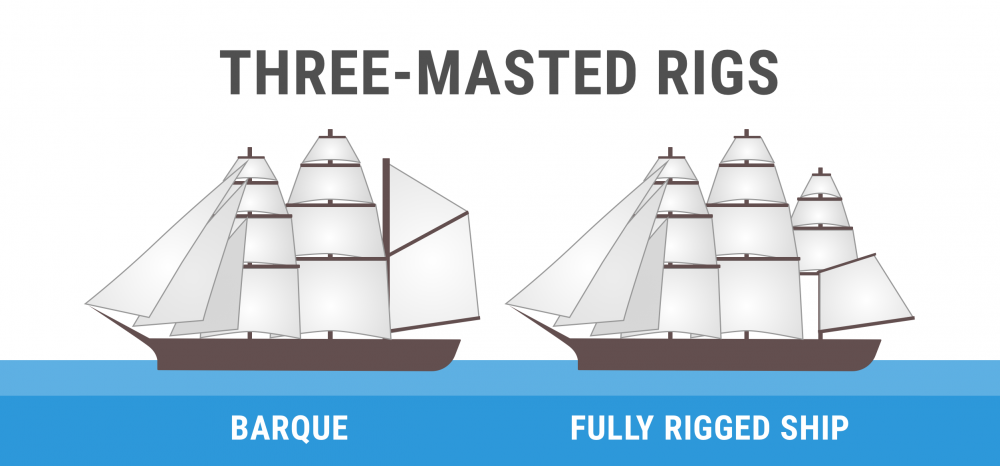
A barque has three or four masts. The fore and mainmast are square-rigged, and the mizzen fore-and-aft, usually gaff-rigged. Carries a mainsail on each mast, but the mainsail shape differs per mast (square or gaff). Barques were built with up to five masts. Four-masted barques were quite common.
Barques were a good alternative to full-rigged ships because they require a lot fewer sailors. But they were also slower. Very popular rig for ocean crossings, so a great rig for merchants who travel long distances and don't want 30 - 50 sailors to run their ship.
Barquentine
The barquentine usually has three masts. The foremast is square-rigged and the main and mizzenmast fore-and-aft. The rear masts are usually gaff-rigged.
Faster than a barque or a schooner, but the performance is worse than both.
The polacca or polacre rig has three masts with a square-rigged foremast. The main and mizzenmast are lateen-rigged. Beautiful boat to see. Polacca literally means 'Polish' (it's Italian). It was a popular rig type in the Mediterranean in the 17th century. It looks like the xebec, which has three lateen-rigged masts.
Fun fact: polaccas were used by a Dutch sailor-turned-Turkish-pirate (called Murat Reis).
The xebec is a Mediterranean trading ship with three masts. All masts are lateen-rigged. I couldn't find any surviving xebecs, only models and paintings. So I guess this rig is outdated a long time.
A boat with three or more masts that all carry square-rigged sails is called a ship, a tall ship, or a full-rigged ship. So it's at this point that we start calling boats 'ships'. It has nothing to do with size but with the type of rigging.
More sails mean less stress on all of them. These ships use a lot of sails to distribute the forces, which reduces the stress on the rigging and the masts. Square sails mean double the sail area in comparison to triangular sails.
They are quite fast for their size, and they could outrun most sloops and schooners (schooners were relatively a lot heavier). The reason is that tall ships could be a lot longer than sloops, giving them a lot of extra hull speed. Sloops couldn't be as large because there weren't strong enough materials available. Try making a single triangular sail with a sail area of over 500 sq. ft. from linen.
So a lot of smaller sails made sense. You could have a large ship with a good maximum hull speed, without your sails ripping apart with every gust of wind.
But you need A LOT of sailors to sail a tall ship: about 30 sailors in total to ie. reef down sails and operate the ship. That's really a lot.
Tall ships are used nowadays for racing, with the popular tall ship races traveling the world. Every four years I go and check them out when they are at Harlingen (which is very close to where I live).
Check out the amazing ships in this video of the tall ship races last year near my hometown. (The event was organized by friends of mine).
What is the difference between a schooner and a sloop? A schooner has two masts, whereas the sloop only has one. The schooner carries more sails, with a mainsail on both masts. Also, sloops are usually Bermuda-rigged, whereas schooners are usually gaff-rigged. Most schooners also carry one or two additional headsails, in contrast to the single jib of the sloop.
What do you call a two-masted sailboat? A two-masted sailboat is most likely a yawl, ketch, schooner, or brig. To determine which one it is you have to locate the mainmast (the tallest). At the rear: schooner or brig. In front: yawl or ketch. Brigs have a square-rigged foremast, schooners don't. Ketches carry a mainsail on the rear mast; yawls don't.
What is a sloop rig? A sloop rig is a sailboat with one mast and two sails: a mainsail and headsail. It's a simple sail plan that handles well and offers good upwind performance. The sloop rig can be sailed shorthanded and is able to sail very close to the wind, making it very popular. Most recreational sailboats use a sloop rig.
What is the difference between a ketch and a yawl? The most important difference between a ketch and a yawl are the position and height of the mizzenmast. The mizzenmast on a yawl is located aft of the rudder, is shorter than the mainmast and doesn't carry a mainsail. On a ketch, it's nearly as long as the mainmast and carries a mainsail.

There are a wonderful lots of DIY changeability shows on the cable airwaves these days.
Rick the rigger
There are SO many errors on this site it really should be taken down.
First major mistake is to say you are no longer afraid of the sea.
One that truly gets up my nose is the term ‘fully’ rigged ship. It’s a FULL rigged ship!! Your mast names are the wrong way round and just because there may be 3 it doesn’t automatically mean the one in the middle is the main.
I could go on and totally destroy your over inflated but fragile ego but I won’t. All I will say is go learn a lot more before posting.
Shawn Buckles
Thanks for your feedback. If you like to point out anything more specific, please let me know and I will update the articles. I’ve changed fully-rigged to full-rigged ship - which is a typo on my part. I try to be as concise as I can, but, obviously, we all make mistakes every now and then. The great thing about the internet is that we can learn from each other and update our knowledge together.
If you want to write yourself and share your knowledge, please consider applying as a writer for my blog by clicking on the top banner.
Thanks, Shawn
Well, I feel that I’ve learned a bit from this. The information is clear and well laid out. Is it accurate? I can’t see anything at odds with the little I knew before, except that I understood a xebec has a square rigged centre mainmast, such as the Pelican ( https://www.adventureundersail.com/ )
Hi, Shawn, You forgot (failed) to mention another type of rig? The oldest type of rig known and still functions today JUNK RIG!
Why are so many of the comments here negative. I think it is wonderful to share knowledge and learn together. I knew a little about the subject (I’m an Aubrey-Maturin fan!) but still found this clarified some things for me. I can’t comment therefore on the accuracy of the article, but it seems clear to me that the spirit of the author is positive. We owe you some more bonhomme I suggest Shawn.
As they say in the Navy: “BZ” - for a good article.
Been reading S.M. Stirling and wanted to understand the ship types he references. Thank you, very helpful.
This site is an awesome starting point for anyone who would like to get an overview of the subject. I am gratefull to Shawn for sharing - Thanks & Kudos to you! If the negative reviewers want to get a deeper technical knowledge that is accurate to the n-th then go study the appropriate material. Contribute rather than destroy another’s good work. Well done Shawn. Great job!
Good stuff Shawn - very helpful. As a novice, it’s too confusing to figure out in bits and pieces. Thanks for laying it out.
First of all I have to say that Rick ‘the rigger’ is obviously the one with the “over inflated but fragile ego” and I laughed when you suggested he share his knowledge on your blog, well played!
As for the content it’s great, hope to read more soon!
Alec Lowenthal
Shawn, I have a painting of a Spanish vessel, two masted, with. Lateen sails on both masts and a jib. The mainsail is ahead of the main mast (fore) and the other is aft of the mizzen mast. Would this be what you call lugger rig? I have not seen a similar picture. Thanks, Alec.
Thank you for your article I found easy to read and understand, and more importantly remember, which emphasises the well written.. Pity about the negative comments, but love your proactive responses!
This vessel, “SEBASTIAN” out of Garrucha, Almería, España, was painted by Gustave Gillman in 1899.
Sorry, picture not accepted!
Thank you for a very informative article. I sail a bit and am always looking for more knowledge. I like the way you put forth your info and I feel if you can’t say anything positive, then that person should have their own blog or keep their opinions to their-self. I will be looking for more from you. I salute your way of dealing with negative comments.
Thank you for a great intro to sailing boats! I searched different sailboats because I use old sails tp make bags and wanted to learn the difference. Way more than I ever expected. Thanks for all the work put in to teach the rest of us.
Your description of a cutter is lacking, and your illustrations of “cutters” are actually cutter-rigged sloops. On a true cutter, the mast is moved further aft (with more than 40% of the ship forward of the mast). A sloop uses tension in the backstay to tension the luff of the foresail. The cutter can’t do this.
Also, a bermuda-rigged ketch will have a line running from the top of the mainmast to the top of the mizzenmast.
wow great guide to rig types! thanks
Interesting guide, however I am confused about the description of the brig. You say the main mast on a brig can have a lateen sail, but in your picture it looks like a gaff sail to me. How is it a lateen sail?
Hi Shawn, thank you for taking the time to share this information. It is clear and very helpful. I am new to sailing and thinking of buying my own blue water yacht. The information you have supplied is very useful. I still am seeking more information on performance and safety. Please keep up the good work. Best Regards
mickey fanelli
I’m starting to repair a model sailboat used in the lake I have three masts that have long been broken off and the sails need replacement. So my question is there a special relationship between the three masts I do have reminents of where the masts should go. they all broke off the boat along with the sails I can figure out where they go because of the old glue marks but it makes no sense. or does it really matter on a model thank you mickey
Cool, total novice here. I have learnt a lot. Thanks for sharing - the diagrams along with the text make it really easy to understand, especially for a beginner who hasn’t even stepped on a sailing boat.
Daryl Beatt
Thank you. Cleared up quite a few things for me. For example, I was familiar with the names “Xebecs” and “Polaccas” from recent reading about the Barbary War. I had gathered that the two Barbary types were better suited to sailing in the Med, but perhaps they were less able to be adaptable to military uses,(but one might assume that would be ok if one plans to board and fight, as opposed to fight a running gun duel). Specifically, the strangely one sided August 1, 1801 battle between the USS Enterprise under Lt. John Sterett and the Polacca cruiser Tripoli under Admiral Rais Mahomet Rous. On paper both ships seemed nearly equal in size, guns and crew, but pictures of the battle are confusing. While the Enterprise is usually rendered as the familiar schooner, the polacca Tripoli has been pictured in radically different ways. Thus the Wikipedia picture by Hoff in 1878 used to illustrate the Battle shows a Brig design for Tripoli, indicating 77 years later, polaccas were no longer common.
Lee Christiansen
I am curious as to what you would call a modern race boat with a fractional jib,not equipped for full masthead hoist? Thanks Lee
Thanks Guy: The information and pictures really eliminate a lot of the mystery of the terminology and the meanings. Also appreciate the insight of the handling idiosyncrasies “hand” (staff) requirements to manage a vessel for one that has not been on the water much. I long to spend significant time afloat, but have concern about the ability to handle a vessel due to advancing age. The Significant Other prefers to sit (in AC comfort)and be entertained by parties of cruise line employees. Thanks again for the information.
Gordon Smith
Your discussion made no mention of the galleon, a vessel with either square-rigged Fore and Main masts and a shorter lateen-rigged Mizzen, or, on larger galleons, square-rigged Fore and Main masts, with a lateen-rigged Mizzen and a lateen-rigged Bonaventure mast, both shorter than either the Fore or Main masts. Also, it was not uncommon for a galleon to hoist a square-rigged bowsprit topsail in addition to the usual square-rigged spritsail.
Leave a comment
You may also like.
What's that sail for? Generally, I don't know. So I've come up with a system. I'll explain you everything there is to know about sails and rigs in this article.
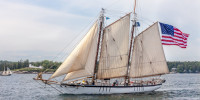
17 Sailboat Types Explained: How To Recognize Them
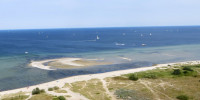
Different Types of Sailing and Racing Explained

How Are Sail Numbers Assigned? (And how to pick yours)

Jordan Yacht Brokerage
We Never Underestimate Your Dreams
Sailboat rig types: sloop, cutter, ketch, yawl, schooner, cat.

Naval architects designate sailboat rig types by number and location of masts. The six designations are sloop, cutter, cat, ketch, yawl, and schooner. Although in defining and describing these six rigs I may use terminology associated with the sail plan, the rig type has nothing to do with the number of sails, their arrangement or location. Such terms that have no bearing on the rig type include headsail names such as jib, genoa, yankee; furling systems such as in-mast or in-boom; and sail parts such as foot, clew, tack, leach, and roach. Rig questions are one of the primary areas of interest among newcomers to sailing and studying the benefits of each type is a good way to learn about sailing. I will deal with the rigs from most popular to least.

Sloop The simplest and most popular rig today is the sloop. A sloop is defined as a yacht whose mast is somewhere between stations 3 and 4 in the 10 station model of a yacht. This definition places the mast with two thirds of the vessel aft and one third forward. The sloop is dominant on small and medium sized yachts and with the shift from large foretriangles (J-dimension in design parlance) to larger mains a solid majority on larger yachts as well. Simple sloop rigs with a single headsail point the highest because of the tighter maximum sheeting angle and therefore have the best windward performance of the rig types. They are the choice for one-design racing fleets and America’s cup challenges. The forestay can attached either at the masthead or some fraction below. These two types of sloops are described respectively as masthead or fractionally rigged. Fractionally rigged sloops where the forestay attaches below the top of the mast allow racers to easily control head and main sail shapes by tightening up the backstay and bending the mast.

Cutter A cutter has one mast like the sloop, and people rightfully confuse the two. A cutter is defined as a yachts whose mast is aft of station 4. Ascertaining whether the mast is aft or forward of station 4 (what if it is at station 4?) is difficult unless you have the design specifications. And even a mast located forward of station 4 with a long bowsprit may be more reasonably referred to as a cutter. The true different is the size of the foretriangle. As such while it might annoy Bob Perry and Jeff_h, most people just give up and call sloops with jibstays cutters. This arrangement is best for reaching or when heavy weather dictates a reefed main. In moderate or light air sailing, forget the inner staysail; it will just backwind the jib and reduce your pointing height.

Ketch The ketch rig is our first that has two masts. The main is usually stepped in location of a sloop rig, and some manufactures have used the same deck mold for both rig types. The mizzen, as the slightly shorter and further aft spar is called, makes the resulting sail plan incredibly flexible. A ketch rig comes into her own on reaching or downwind courses. In heavy weather owners love to sail under jib and jigger (jib and mizzen). Upwind the ketch suffers from backwinding of the mizzen by the main. You can add additional headsails to make a cutter-ketch.

Yawl The yawl is similar to the ketch rig and has the same trade-offs with respect to upwind and downwind performance. She features two masts just like on a ketch with the mizzen having less air draft and being further aft. In contrast and much like with the sloop vs. cutter definition, the yawl mizzen’s has much smaller sail plan. During the CCA era, naval architects defined yawl as having the mast forward or aft of the rudderpost, but in today’s world of hull shapes (much like with the sloop/cutter) that definition does not work. The true different is the height of the mizzen in proportion to the main mast. The yawl arrangement is a lovely, classic look that is rarely if ever seen on modern production yachts.
Schooner The schooner while totally unpractical has a romantic charm. Such a yacht features two masts of which the foremost is shorter than the mizzen (opposite of a ketch rig). This change has wide affects on performance and sail plan flexibility. The two masts provide a base to fly unusual canvas such as a mule (a triangular sail which spans between the two spars filling the space aft of the foremast’s mainsail). The helm is tricky to balance because apparent wind difference between the sails, and there is considerable backwinding upwind. Downwind you can put up quite a bit of canvas and build up speed.

Cat The cat rig is a single spar design like the sloop and cutter, but the mast location is definately forward of station 3 and maybe even station. You see this rig on small racing dinghies, lasers and the like. It is the simplest of rigs with no headsails and sometimes without even a boom but has little versatility. Freedom and Nonesuch yachts are famous for this rig type. A cat ketch variation with a mizzen mast is an underused rig which provides the sailplan flexibility a single masted cat boat lacks. These are great fun to sail.
Conclusion Sloop, cutter, ketch, yawl, schooner, and cat are the six rig types seen on yachts. The former three are widely more common than the latter three. Each one has unique strengths and weaknesses. The sloop is the best performing upwind while the cat is the simplest form. Getting to know the look and feel of these rig types will help you determine kind of sailing you enjoy most.
5 Replies to “Sailboat Rig Types: Sloop, Cutter, Ketch, Yawl, Schooner, Cat”
Thanks for this information. I’m doing my research on what type of sailboat I will eventually buy and was confused as to all the different configurations! This helped quite a bit.
- Pingback: ketch or schooner - Page 2 - SailNet Community
- Pingback: US Coast Guard Auxiliary Courses – Always Ready! | Escape Artist Chronicles
Being from the south, my distinction between a ketch and a yawl: if that mizzen falls over on a ketch, the boat will catch it; if it falls over on a yawl, it’s bye bye y’all.
I thought a Yawl had to have the mizzen mast behind the rudder and a ketch had the mizzen forward of the rudder.
Leave a Reply
Your email address will not be published. Required fields are marked *
Save my name, email, and website in this browser for the next time I comment.
How To Tell The Difference Between A Ketch And A Schooner
A Definitive Guide
Sloops and cutters.
Let’s start off with the basics.
Most sailing vessels have only one mast and would be classed as sloops or cutters. A sloop has one headsail, a cutter has two or more. Sloops and cutters can be either gaff rigged like the drawing here or bermudan rigged like most yachts. The majority of yachts today will be bermudan sloops.
Where’s the mizzen mast?
In most cases it’s the after-most mast. A ketch or yawl has a main mast and a mizzen mast but on a two masted schooner or square rigger such as a brig or brigantine the masts are called the fore mast and main mast. On three masted square riggers and schooners the mizzen is the after-most mast. More than three masts? Lets not go there just now…
Ketches and Yawls
A ketch has two masts with the mizzen mast stepped before the rudder head.
If the mast is stepped aft of the rudder head the boat becomes technically a yawl not a ketch. Yawl rig tends to be used on smaller boats, ketch rig is often used on larger vessels, notably the Brixham trawlers and trading ketches of the last century.
The mizzen sail in a ketch is a driving sail, in a yawl it is more of a balancing sail . The mizzen sail is always is smaller, often much smaller than the mainsail. If it was the same size or larger the boat would be a schooner.
Why not take a look at our fantastic Schooner Sailing Holidays while you are here?
Or maybe just scroll past for the rest of this article and our ‘Learn To Sail A Schooner’ articles.
Schooners have two or more masts. The defining thing for a schooner is that the after masts must be the same height or greater than the foremast.
Two masted schooners are simply called schooners , schooners with more than two masts are called by the number of masts they have unless that is they are a topsail schooner. The American seven masted schooner, the Thomas Lawson had more masts than any other schooner but was the only one of its kind.
When Does A Schooner Become A Topsail Schooner? Any time a schooner has a square topsail it becomes a topsail schooner. They were once common in the UK and were just called schooners, a schooner without square topsails was called a fore and aft schooner.
In America the situation was reversed and the standard schooner did not carry square topsails.
Sprit rig is usually reserved for dinghies but is also used on the Thames barges. The sprit is the spar that runs diagonally across the largest sail . This rig is not ideal in a big seaway because the sprit cannot be lowered and could become an unmanageable weight aloft. In coastal waters it is an extremely handy rig, the topsail can catch a high up breeze above river banks and the mainsail can be quickly brailed up to the sprit if bit of a breeze gets up (it’s like drawing a large curtain)
If you want to know more about its use in dinghies there is an article coming soon on our web site.
More ‘Learn To Sail A Schooner’ Articles
Learn to sail a schooner no.1, learn to sail a schooner no.3, learn to sail a schooner no.2, learn to sail a schooner no.6, learn to sail a schooner no.7, learn to sail a schooner no.8, learn to sail a schooner no.4, learn to sail a schooner no.5, tall ships sailing holidays 2024.
Voyages In Date Order
Sailing Weekend Breaks UK
An offshore sailing holiday orkney, orkney sailing holiday, fair isle sailing holiday, shetland sailing holiday, kirkwall, orkney to whitby, whitby to harwich, ipswich to london, sailing london to harwich.
SchoonerSail Limited 16A Stafford Mill London Road Thrupp Stroud Gloucestershire GL5 2A
This site uses cookies. By continuing to browse the site, you are agreeing to our use of cookies.
Cookie and Privacy Settings
We may request cookies to be set on your device. We use cookies to let us know when you visit our websites, how you interact with us, to enrich your user experience, and to customize your relationship with our website.
Click on the different category headings to find out more. You can also change some of your preferences. Note that blocking some types of cookies may impact your experience on our websites and the services we are able to offer.
These cookies are strictly necessary to provide you with services available through our website and to use some of its features.
Because these cookies are strictly necessary to deliver the website, refusing them will have impact how our site functions. You always can block or delete cookies by changing your browser settings and force blocking all cookies on this website. But this will always prompt you to accept/refuse cookies when revisiting our site.
We fully respect if you want to refuse cookies but to avoid asking you again and again kindly allow us to store a cookie for that. You are free to opt out any time or opt in for other cookies to get a better experience. If you refuse cookies we will remove all set cookies in our domain.
We provide you with a list of stored cookies on your computer in our domain so you can check what we stored. Due to security reasons we are not able to show or modify cookies from other domains. You can check these in your browser security settings.
We also use different external services like Google Webfonts, Google Maps, and external Video providers. Since these providers may collect personal data like your IP address we allow you to block them here. Please be aware that this might heavily reduce the functionality and appearance of our site. Changes will take effect once you reload the page.
Google Webfont Settings:
Google Map Settings:
Google reCaptcha Settings:
Vimeo and Youtube video embeds:
You can read about our cookies and privacy settings in detail on our Privacy Policy Page.
Types of Sailboats: A Complete Guide

Learning the different types of sailboats can help you identify vessels and choose the right boat.
In this article, we'll cover the most common kinds of sailboats, their origins, and what they're used for. We'll also go over the strengths and weaknesses of each design, along with when they're most useful.
The most common kind of sailboat is the sloop, as it's simple to operate and versatile. Other common sailboat types include the schooner, cutter, cat, ketch, schooner, catamaran, and trimaran. Other sailboat variations include pocket cruisers, motorsailers, displacement, and shoal-draft vessels.
The information found in this article is sourced from boat reference guides, including A Field Guide to Sailboats of North America by Richard M. Sherwood and trusted sources in the sailing community.
Table of contents
Distinguishing Types of Sailboats
In this article, we'll distinguish sailboats by traits such as their hull type, rig, and general configuration. Some sailboats share multiple characteristics with other boats but fall into a completely different category. For example, a sailboat with a Bermuda rig, a large engine, and a pilothouse could technically be called a sloop, but it's more likely a motorsailer.
When discerning sailboat type, the first most obvious place to look is the hull. If it has only one hull, you can immediately eliminate the trimaran and the catamaran. If it has two or more hulls, it's certainly not a typical monohull vessel.
The next trait to consider is the rig. You can tell a lot about a sailboat based on its rig, including what it's designed to be used for. For example, a long and slender sailboat with a tall triangular rig is likely designed for speed or racing, whereas a wide vessel with a complex gaff rig is probably built for offshore cruising.
Other factors that determine boat type include hull shape, overall length, cabin size, sail plan, and displacement. Hull material also plays a role, but every major type of sailboat has been built in both wood and fiberglass at some point.
Sailboat vs. Motorsailer
Most sailboats have motors, but most motorized sailboats are not motorsailers. A motorsailer is a specific kind of sailboat designed to run efficiently under sail and power, and sometimes both.
Most sailboats have an auxiliary engine, though these power plants are designed primarily for maneuvering. These vessels cannot achieve reasonable speed or fuel-efficiency. Motorsailers can operate like a powerboat.
Motorsailers provide great flexibility on short runs. They're great family boats, and they're popular in coastal communities with heavy boat traffic. However, these features come at a cost. Motorsailers aren't the fastest or most efficient powerboats, and they're also not the most agile sailboats. That said, they make an excellent general-purpose sailing craft.
Monohull vs. Multi-hull: Which is Better?
Multihull sailboats are increasingly popular, thanks to advances and lightweight materials, and sailboat design. But are they better than traditional sailboats? Monohulls are easier to maintain and less expensive, and they offer better interior layouts. Multihulls are more stable and comfortable, and they're significantly easier to control. Multihull sailboats also have a speed advantage.
Monohull Sailboats
A monohull sailboat is a traditionally-shaped vessel with a single hull. The vast majority of consumer sailboats are monohulls, as they're inexpensive to produce and easy to handle. Monohull sailboats are proven and easy to maintain, though they lack the initial stability and motion comfort of multi-hull vessels.
Monohull sailboats have a much greater rig variety than multi-hull sailboats. The vast majority of multihull sailboats have a single mast, whereas multi-masted vessels such as yawls and schooners are always monohulls. Some multi-hull sailboats have side-by-side masts, but these are the exception.
Catamaran Sailboats
The second most common sailboat configuration is the catamaran. A catamaran is a multihull sailboat that has two symmetrical hulls placed side-by-side and connected with a deck. This basic design has been used for hundreds of years, and it experienced a big resurgence in the fiberglass boat era.
Catamarans are fast, efficient, and comfortable. They don't heel very much, as this design has excellent initial stability. The primary drawback of the catamaran is below decks. The cabin of a catamaran is split between both hulls, which often leaves less space for the galley, head, and living areas.
Trimaran Sailboats
Trimarans are multi-hull sailboats similar to catamarans. Trimarans have three hulls arranged side-by-side. The profile of a trimaran is often indistinguishable from a catamaran.
Trimarans are increasingly popular, as they're faster than catamarans and monohulls and considerably easier to control. Trimarans suffer from the same spatial limitations as catamarans. The addition of an extra hull adds additional space, which is one reason why these multi-hull vessels are some of the best-selling sailboats on the market today.
Sailboat Rig Types
Rigging is another way to distinguish sailboat types. The rig of a sailboat refers to it's mast and sail configuration. Here are the most common types of sailboat rigs and what they're used for.
Sloops are the most common type of sailboat on the water today. A sloop is a simple single-mast rig that usually incorporates a tall triangular mainsail and headsail. The sloop rig is easy to control, fun to sail, and versatile. Sloops are common on racing sailboats as they can sail quite close to the wind. These maneuverable sailboats also have excellent windward performance.
The sloop rig is popular because it works well in almost any situation. That said, other more complex rigs offer finer control and superior performance for some hull types. Additionally, sloops spread their entire sail area over just to canvases, which is less flexible than multi-masted rigs. The sloop is ideal for general-purpose sailing, and it's proven itself inland and offshore.
Sloop Features:
- Most popular sailboat rig
- Single mast
- One mainsail and headsail
- Typically Bermuda-rigged
- Easy to handle
- Great windward performance
- Less precise control
- Easier to capsize
- Requires a tall mast

Suitable Uses:
- Offshore cruising
- Coastal cruising
Cat (Catboat)
The cat (or catboat) is a single-masted sailboat with a large, single mainsail. Catboats have a thick forward mast, no headsail, and an exceptionally long boom. These vessels are typically gaff-rigged, as this four-edged rig offers greater sail area with a shorter mast. Catboats were popular workboats in New England around the turn of the century, and they have a large following today.
Catboats are typically short and wide, which provides excellent stability in rough coastal conditions. They're hardy and seaworthy vessels, but they're slow and not ideal for offshore use. Catboats are simple and easy to control, as they only have a single gaff sail. Catboats are easy to spot thanks to their forward-mounted mast and enormous mainsail.
Catboat Features:
- Far forward-mounted single mast
- Large four-sided gaff sail
- Short and wide with a large cockpit
- Usually between 20 and 30 feet in length
- Excellent workboats
- Tough and useful design
- Great for fishing
- Large cockpit and cabin
- Not ideal for offshore sailing
- Single sail offers less precise control
- Slow compared to other rigs
- Inland cruising
At first glance, a cutter is difficult to distinguish from a sloop. Both vessels have a single mast located in roughly the same position, but the sail plan is dramatically different. The cutter uses two headsails and often incorporates a large spar that extends from the bow (called a bowsprit).
The additional headsail is called a staysail. A sloop only carries one headsail, which is typically a jib. Cutter headsails have a lower center of gravity which provides superior performance in rough weather. It's more difficult to capsize a cutter, and they offer more precise control than a sloop. Cutters have more complex rigging, which is a disadvantage for some people.
Cutter Features:
- Two headsails
- Long bowsprit
- Similar to sloop
- Gaff or Bermuda-rigged
- Fast and efficient
- Offers precise control
- Superior rough-weather performance
- More complex than the sloop rig
- Harder to handle than simpler rigs
Perhaps the most majestic type of sailboat rig, the schooner is a multi-masted vessel with plenty of history and rugged seaworthiness. The schooner is typically gaff-rigged with short masts and multiple sails. Schooners are fast and powerful vessels with a complex rig. These sailboats have excellent offshore handling characteristics.
Schooners have a minimum of two masts, but some have three or more. The aftermost large sail is the mainsail, and the nearly identical forward sail is called the foresail. Schooners can have one or more headsail, which includes a cutter-style staysail. Some schooners have an additional smaller sale aft of the mainsail called the mizzen.
Schooner Features:
- At least two masts
- Usually gaff-rigged
- One or more headsails
- Excellent offshore handling
- Precise control
- Numerous sail options (headsails, topsails, mizzen)
- Fast and powerful
- Complex and labor-intensive rig
- Difficult to adjust rig single-handed
- Offshore fishing
Picture a ketch as a sloop or a cutter with an extra mast behind the mainsail. These vessels are seaworthy, powerful, excellent for offshore cruising. A ketch is similar to a yawl, except its larger mizzen doesn't hang off the stern. The ketch is either gaff or Bermuda-rigged.
Ketch-rigged sailboats have smaller sails, and thus, shorter masts. This makes them more durable and controllable in rough weather. The mizzen can help the boat steer itself, which is advantageous on offshore voyages. A ketch is likely slower than a sloop or a cutter, which means you aren't likely to find one winning a race.
Ketch Features:
- Headsail (or headsails), mainsail, and mizzen
- Mizzen doesn't extend past the rudder post
- Good offshore handling
- Controllable and mild
- Shorter and stronger masts
- Easy self-steering
- Slower than sloops and cutters
- Less common on the used market
A dinghy is a general term for a small sailboat of fewer than 28 feet overall. Dinghys are often dual-power boats, which means they usually have oars or a small outboard in addition to a sail. These small boats are open-top and only suitable for cruising in protected waters. Many larger sailboats have a deployable dinghy on board to get to shore when at anchor.
Dinghy Features:
- One or two people maximum capacity
- Easy to sail
- Works with oars, sails, or an outboard
- Great auxiliary boat
- Small and exposed
- Not suitable for offshore use
- Going from anchor to shore
- Protected recreational sailing (lakes, rivers, and harbors)
Best Sailboat Type for Stability
Stability is a factor that varies widely between sailboat types. There are different types of stability, and some sailors prefer one over another. For initial stability, the trimaran wins with little contest. This is because these vessels have a very high beam-to-length ratio, which makes them much less prone to rolling. Next up is the catamaran, which enjoys the same benefit from a wide beam but lacks the additional support of a center hull section.
It's clear that in most conditions, multihull vessels have the greatest stability. But what about in rough weather? And what about capsizing? Multihull sailboats are impossible to right after a knockdown. This is where full-keel monohull sailboats excel.
Traditional vessels with deep displacement keels are the safest and most stable in rough weather. The shape, depth, and weight of their keels keep them from knocking over and rolling excessively. In many cases, these sailboats will suffer a dismasting long before a knockdown. The primary disadvantage of deep-keeled sailboats is their tendency to heel excessively. This characteristic isn't hazardous, though it can make novice sailors nervous and reduce cabin comfort while underway.
Best Sailboat Type for Offshore Cruising
The best sailboat type for offshore cruising is the schooner. These graceful aid robust vessels have proven themselves over centuries as durable and capable vessels. They typically use deep displacement keels, which makes them stable in rough weather and easy to keep on course.
That said, the full answer isn't quite so simple. Modern multihull designs are an attractive option, and they have also proven to be strong and safe designs. Multihull sailboats are an increasingly popular option for offshore sailors, and they offer comfort that was previously unknown in the sailing community.
Many sailors cross oceans in basic Bermuda-rigged monohulls and take full advantage of a fin-keel design speed. At the end of the day, the best offshore cruising sailboat is whatever you are comfortable handling and living aboard. There are physical limits to all sailboat designs, though almost any vessel can make it across an ocean if piloted by a competent skipper and crew.
Best Sailboat Type for Racing The modern lightweight Bermuda-rigged sailboat is the king of the regatta. When designed with the right kind of hull, these vessels are some of the fastest sailboats ever developed. Many boats constructed between the 1970s and today incorporate these design features due to their favorable coastal and inland handling characteristics. Even small sailboats, such as the Cal 20 and the Catalina 22, benefit from this design. These boats are renowned for their speed and handling characteristics.
Related Articles
Daniel Wade
I've personally had thousands of questions about sailing and sailboats over the years. As I learn and experience sailing, and the community, I share the answers that work and make sense to me, here on Life of Sailing.
by this author
Learn About Sailboats
Most Recent

Dufour Sailboats Guide & Common Problems
October 16, 2024

What Does "Sailing By The Lee" Mean?
October 3, 2023
Important Legal Info
Lifeofsailing.com is a participant in the Amazon Services LLC Associates Program, an affiliate advertising program designed to provide a means for sites to earn advertising fees by advertising and linking to Amazon. This site also participates in other affiliate programs and is compensated for referring traffic and business to these companies.
Similar Posts

The Best Sailing Schools And Programs: Reviews & Ratings
September 26, 2023

Affordable Sailboats You Can Build at Home
September 24, 2024
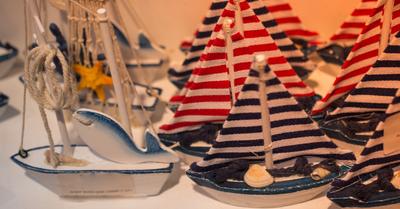
Best Small Sailboat Ornaments
September 12, 2023
Popular Posts

Best Liveaboard Catamaran Sailboats
December 28, 2023

Can a Novice Sail Around the World?
Elizabeth O'Malley
June 15, 2022

4 Best Electric Outboard Motors

How Long Did It Take The Vikings To Sail To England?

10 Best Sailboat Brands (And Why)
December 20, 2023

7 Best Places To Liveaboard A Sailboat
- Types of Sailboats
- Parts of a Sailboat
- Cruising Boats
- Small Sailboats
- Design Basics
- Sailboats under 30'
- Sailboats 30'-35
- Sailboats 35'-40'
- Sailboats 40'-45'
- Sailboats 45'-50'
- Sailboats 50'-55'
- Sailboats over 55'
- Masts & Spars
- Knots, Bends & Hitches
- The 12v Energy Equation
- Electronics & Instrumentation
- Build Your Own Boat
- Buying a Used Boat
- Choosing Accessories
- Living on a Boat
Sailboat Cruising Tips for Beginners
- Sailing in the Caribbean
- Anchoring Skills
- Sailing Authors & Their Writings
- Mary's Journal
- Nautical Terms
- Cruising Sailboats for Sale
- List your Boat for Sale Here!
- Used Sailing Equipment for Sale
- Sell Your Unwanted Gear
- Sailing eBooks: Download them here!
- Your Sailboats
- Your Sailing Stories
- Your Fishing Stories
- Advertising
- What's New?
- Chartering a Sailboat
The Different Types of Sailboats
If you’re a sailboat fanatic like me, all types of sailboats will attract your attention. Some more so than others admittedly, but all will have something about them that catches your eye.
If you’re not a fanatic (not yet, that is) but just an interested observer, then the first thing you’ll notice about a sailboat will be how many masts it has and the configuration of its sails - in other words, its 'rig'.
This observation alone will enable you to identify the five main types of sailboats — sloops, cutters, ketches, yawls and schooners - all of which are described here.
But apart from the various rig types, you can describe types of sailboats from a different viewpoint - sailing dinghies, dayboats, motorsailors, monohulls, catamarans and trimarans.
Let's make a start with the various rig types...
A single-masted sailboat with just two sails — a foresail (aka headsail or jib) and a mainsail — is a sloop, the purest type of sailboat.
The sloop rig can also be described as a Bermuda rig, Bermudian rig or Marconi rig.
Read more about sloops...
Examples of Sloops
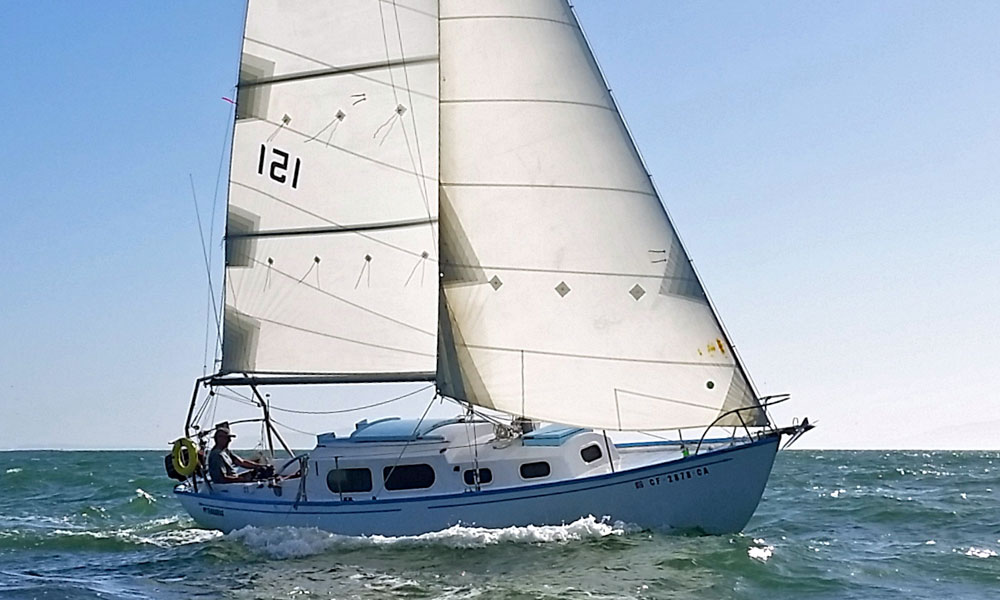
If a sloop has an additional sail between the headsail and the mainsail, then it's no longer a sloop - it's a cutter.
Some cutters - like the one shown here - have the foresail set forward on a bowsprit, with the inner forestay permanently rigged to the stemhead where the foresail otherwise would be, or to a central chainplate further aft on the foredeck.
Read more about cutters...
Examples of Cutters
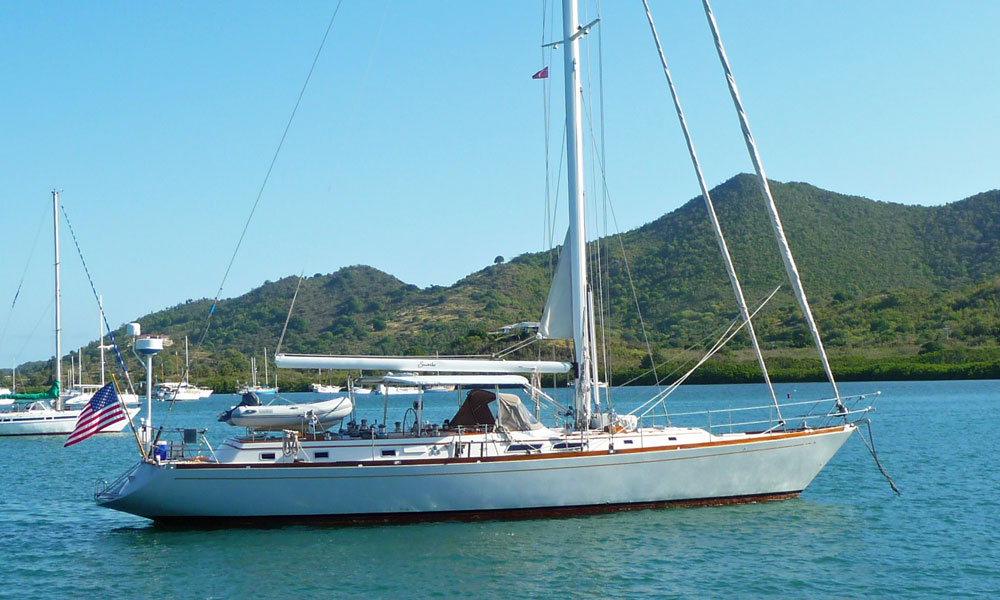
The following boats may look like cutters with their double headsails, but they're not cutters at all...
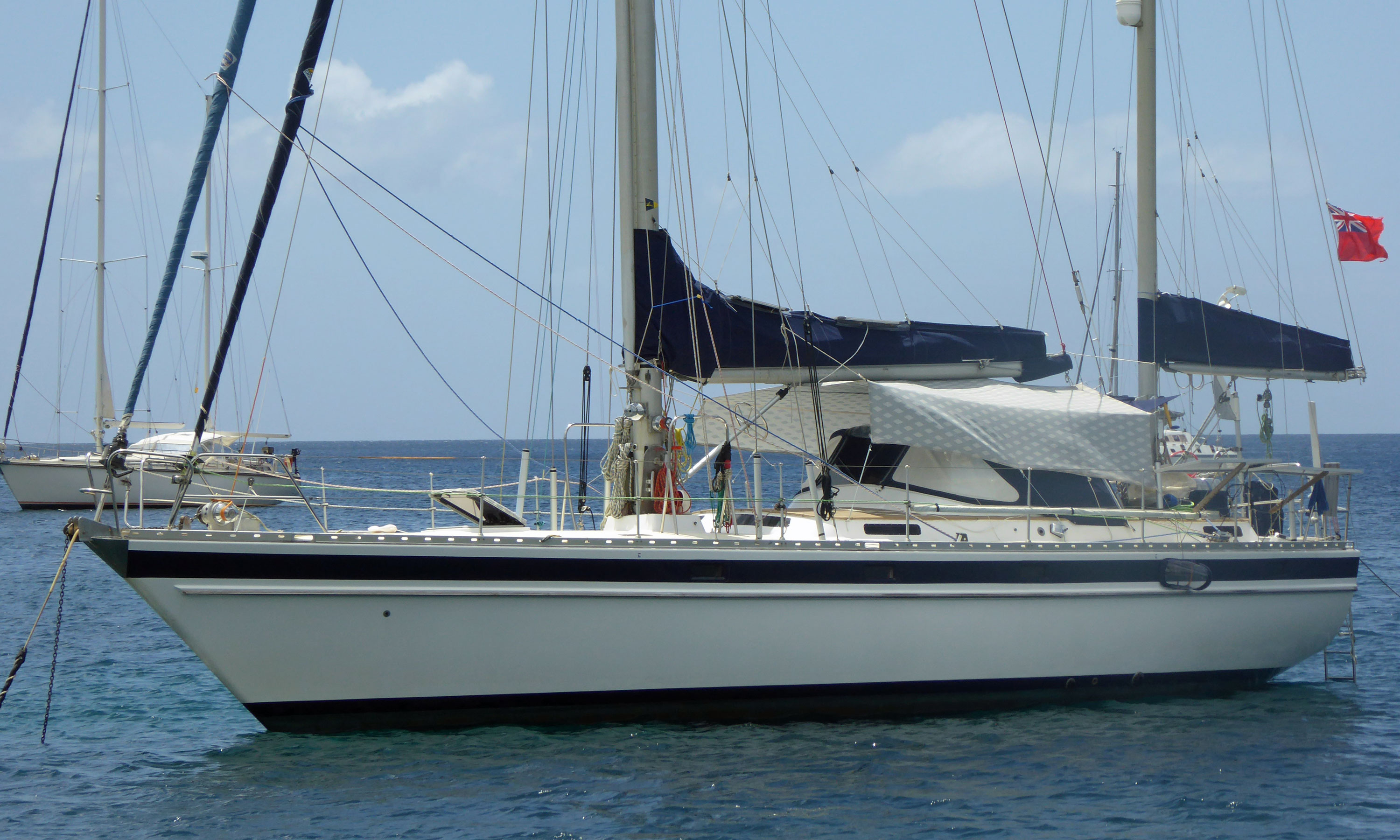
To find out why, click here...
A ketch is a two-masted sailboat, a main mast forward and a shorter mizzen mast aft.
But not all two-masted sailboats are ketches — they might be yawls (see below).
A ketch may also sport a staysail, with or without a bowsprit, in which case it would be known as a cutter-rigged or staysail ketch.
Read more about ketches...
Examples of Ketches
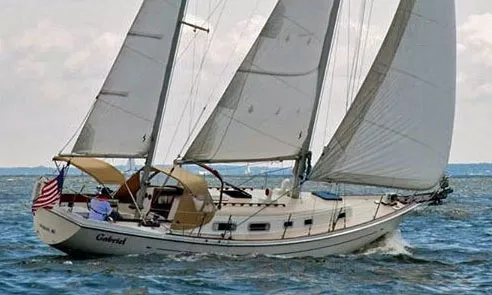
Note that the Ocean 71 and the Irwin 52 are cutter-rigged, and are traditionally referred to as Staysail Ketches .
Cat Ketches
Cat-ketches are recognised by the lack of any standing rigging to support their pair of unstayed masts.
And yes, if the after mast is taller than the foremast then it's called a cat- schooner sailboat.
Read more about cat-ketches...
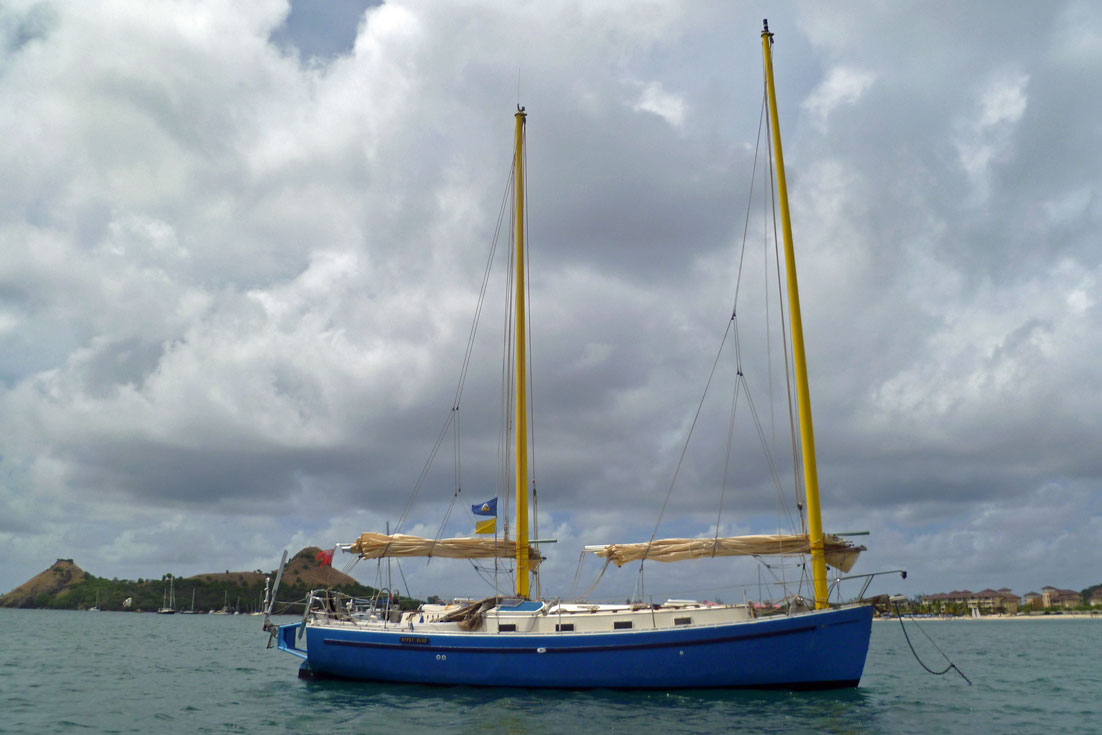
Yawls have their origins as old-time sail fishing boats, where the small mizzen sail was trimmed to keep the vessel steady when hauling the nets.
Much like a ketch, the difference being that the yawl has the mizzen mast positioned aft of the rudder post whereas the ketch has its mizzen mast ahead of the rudder post.
You’ll not be surprised to learn that a yawl with a staysail is known as cutter-rigged yawl.
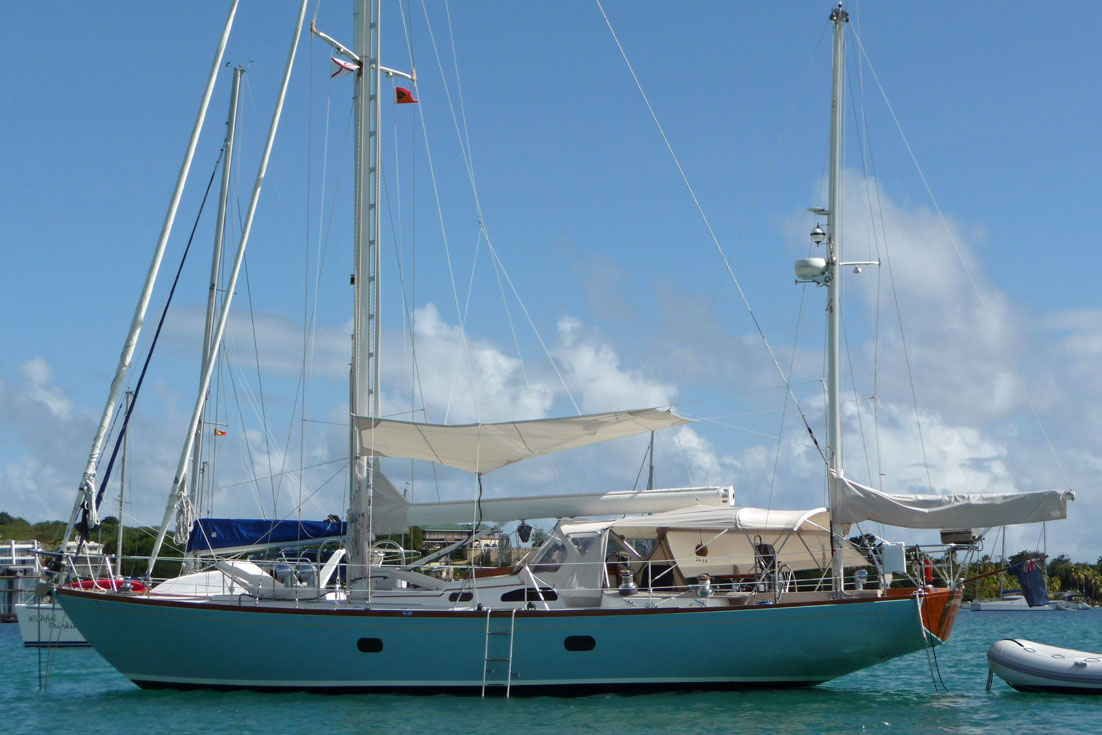
A schooner is a two-or-more masted sailboat, in which the aft-most mast - the mainmast - is the same height or taller than the foremast.
The one shown here is gaff cutter rigged, with a topsail set on the mainmast.
Many sailors agree that of all the different types of sailboats, a schooner under full sail is one of the most beautiful sights afloat.
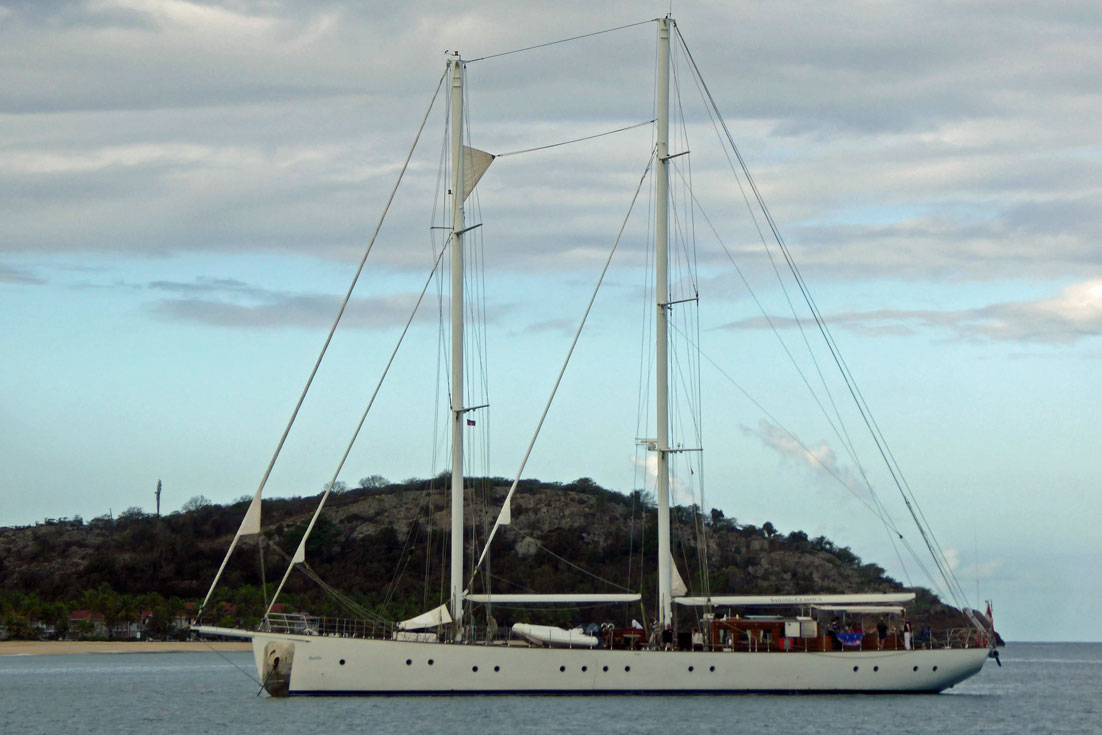
Gaffed-rigged sailboats, or 'gaffers', have their mainsail supported by a spar - the 'gaff' - which is hauled up mast by a separate halyard.
Often these types of sailboats are rigged with a topsail, as shown here and in the gaff schooner above, which really adds some grunt in light airs.
All this comes at a price of course, both in terms of material cost and weight aloft, which is why very few modern yachts are fitted with gaff rigs these days.
All artwork on this page is by Andrew Simpson
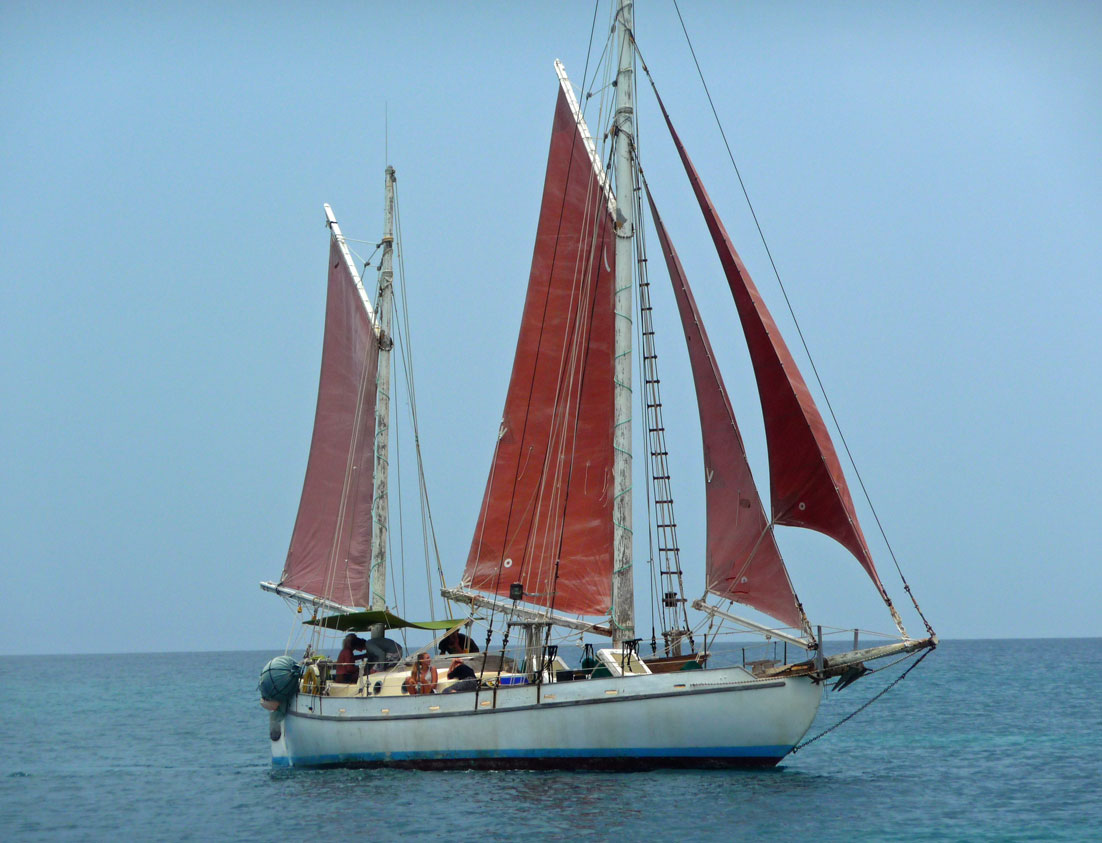
Examples of the Various Types of Sailboats...
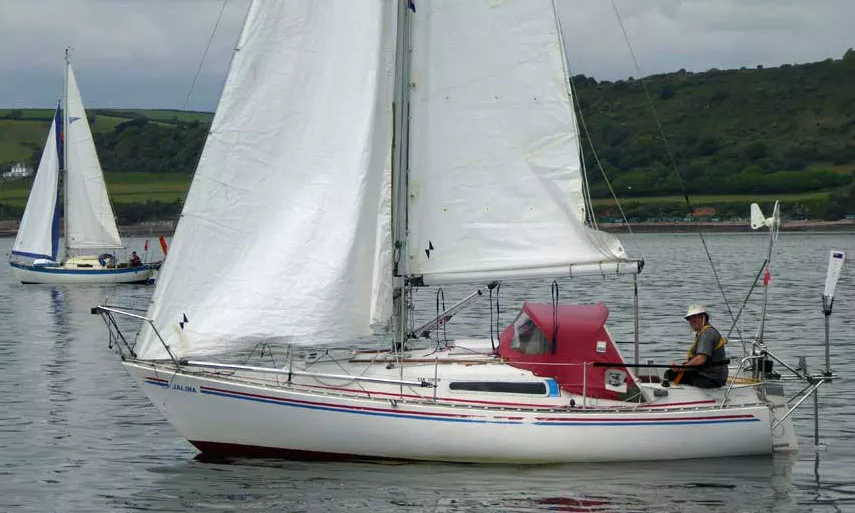
Other Types of Sailboats
The seven sailboat rig variations shown here are the most popular types of modern cruising boat rigs, but there are other rig versions which were once found on commercial, fishing, and naval sailing vessels.
They include:
- Full square-rigged sailing vessels
- Barkentines
- Brigantines
And you can see examples of them here ...
In this article I've said that ketches, yawls and schooners with two headsails can be called cutter rigged. This is a commonly used description but strictly speaking, there's only one rig that can accurately be called a cutter - and that's a single-masted sailboat with two headsails. My thanks to 'Old Salt' for drawing my attention to this!
Recent Articles
'The Dream', a Hallberg-Rassy 41 for Sale
Nov 07, 24 10:55 AM
The Nicholson 32 Mk10 Sailboat
Nov 02, 24 09:45 AM
Oct 29, 24 12:47 PM
Here's where to:
- Find Used Sailboats for Sale...
- Find Used Sailing Gear for Sale...
- List your Sailboat for Sale...
- List your Used Sailing Gear...
Our eBooks...

A few of our Most Popular Pages...
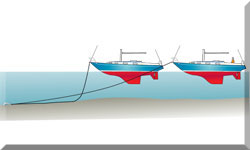
Copyright © 2024 Dick McClary Sailboat-Cruising.com
- Bottom Painting & Prop Speed
- Fiberglass & Paint Work
- Running Gear & Valves
- Full-Service Team
- Monthly Maintenance Programs
- Dockside Service Team
- Full-Service Boatyard
- Management Services
- Accounting & Reporting
- Relevant Management Experience
- News and Media
Boats, Schooners, Ships, Yachts and Superyachts - What’s the Difference?
Are boats, yachts and superyachts all the same? What happens if we throw ship in the mix, or vessel? Do they refer to different boat types or are they just interchangeable terms? Will some sea lover become upset if I refer to a boat as a schooner? What’s a schooner anyway? Some require yacht crews while others can be sailed solo.
For those who are new to sea life, it’s okay to not understand the difference. There are still some sea lovers who couldn’t tell you the difference between yachts and superyachts, between boats and ships. And some may say it doesn’t even matter. Some distinctions are clear, like the difference between a ship and schooner. While other differences are more difficult to establish, like the difference between yachts and superyachts.
Here’s a simple cheat sheet. Bookmark this page in case it comes up again! Happy sailing!
Boat – used for commercial and recreational purposes. Technically, boats are motor vessels less than 100 feet long.
Schooner – a sailboat that actually has a sail. Some schooners can also make use of an engine, but if there is no sail, it is not a schooner.
Ship – large, commercial sea vessel. Used to transport goods, people, and for military utility. Ships are usually over 200 feet long.
Yacht – purely recreational vessel. These vessels are built with the idea of luxury in mind. Not all of these vessels require yacht crews, some require 2 or 3 crew members.
Superyacht – a yacht over 100 feet in length from stern to bow. Superyachts cannot function without yacht crews and yacht management .
Regardless of whether you own a large schooner, yacht, or superyacht under 120 feet, Yacht Management has concierge crew, storage, and dockside maintenance services for your vessel. Contact us today for more information and see which packages we offer for your specific kind of vessel – now that you know!

For all inquiries, fill out the form below and a member of our team will respond as soon as possible

- All Courses
- RYA Start Yachting
- RYA Competent Crew
- Novice to RYA Day Skipper
- RYA Day Skipper Fastrack
- RYA Day Skipper Practical
- RYA ICC Flotilla Course
- Sailing Refresher
- RYA Coastal Skipper Combined
- RYA Coastal Skipper Practical
- RYA Yachtmaster Coastal
- RYA Yachtmaster Offshore
- All Adventures
- New Year Sailing into 2025
- Mile Builders
- Gibraltar to Africa Weekend Adventure
- Round the Island Race
- Spain Sailing : Cultural adventures under sail
- All Yachtmaster Courses
- Professional Yachtmaster Fastrack program
- RYA Yachtmaster Theory
- Extended Yachtmaster Preparation
- Passage Making and YM Preparation Course
- Online Courses
- RYA Online Theory Course
- RYA Online VHF / SRC
- RYA PPR Online Course
- Yacht Charter Gibraltar
- Full Day Charter and Half Day Charters
- Frequently Asked Questions
- Joining Instructions
- Special Offers
- Gift Vouchers
- Pre Course Experience
- How to Get Here
- Why Choose Jolly Parrot
- Jolly Reviews
- Where We Sail
- Our Jolly Fleet
- Helping You Choose
- Where are the Parrots?
- Gibraltar Weather
- Sailing Glossary
- Jolly Links
- Terms & Conditions
- Photo Gallery
What is the difference between a Sloop, Ketch, Yawl and Schooner
18 June 2019
It’s probably fair to assume that for every sailing term there are at least 3 or more other pieces of jargon that fit equally as well. Sailing terminology can be confusing, although in the writer’s experience, the more experienced a sailor you sail with (especially racers) the more relaxed about it they become. I’ve lost count of the number of times I’ve heard a very experienced offshore sailor request “a little on the yellow string please..”
That said, when it comes to types of sailing craft, terminology is pretty much definitive. Knowing your yawl from your ketch and your ketch from your schooner may not be critical - but sometimes it’s just useful to know. So here goes;
A sloop has a mainsail and headsail configuration, the mainsail being set on the mast at its luff and and a spar at its foot called a boom.
A schooner has two or more masts with the foreward-most mast shorter than the others. Most schooners are larger sailing vessels and tall ships these days.
The ketch has two masts with the aftmost mast (the mizzen) shorter than the main mast forward of it. The helm position lies to the aft of the mizzen mast.
A yawl, like a ketch has two masts with the aftmost (the mizzen) shorter than the main, but in the case of a yawl, the helming position is forward of the mizzen mast.
All of these yacht types can be rigged differently, the two best known types being gaff-rigged, where the sail is connected to two spars, one at the top of the sail and one at the foot. The sail is quite square and to hoist it the top gaff must be hoisted up the mast, raising the sail under it.
The second, and by far most popular type of mainsail is the Bermuda-rigged vessel where a triangular sail is hoisted up the mast by a halyard attached to its head. The foot is attached to the boom, usually at the tack and clue, but sometimes by way of a bolt rope in its foot which slots into the boom along its whole length.
If the vessel has more than one forestay and flies two or more headsails then it is said to be cutter-rigged. In such cases the main mast might be set slightly further back to accommodate the extra stays. If the forestay connects to the top of the mast then the vessel is ‘masthead’ rigged and if it connects a few feet or metres below the top of the mast it’s a fractional rig, allowing ‘rake’ to be induced in the mast by tensioning the backstay. Most fractionally-rigged yachts have additional bracing aft the mast in the form of ‘running backstays’ which are set and tensioned dependent of the tack and point of sail.
In addition to these vessel types we also have the catboat (usually a vessel with one mainsail set on a mast set more forward than usual), a dinghy (which I doubt needs explanation) and then there are the ships and multi-hulls, of which there are far too many for this blog!
Needless to say, if you ever find yourself confronted by a Jackass-barque, a Brigantine and a Pentamaran and your crew ask you to explain which is which, you’re best to just nod sagely, smile and go put the kettle on..
Other Blog Articles
Using a lead line.
27 October 2024
Isobar weather maps explained
Christmas gift suggestions for the sailor in your llife.
26 October 2024

IMAGES
COMMENTS
Ketch : - 1 mainsail - 2 jib or genoa - 3 mizzen. A ketch has the mizzen mast (at the stern) smaller than the main mast (called mainmast). To be a ketch, the mizzen mast must be placed forward of the helm, or more precisely of the rudder. If the mizzen mast is aft, we are dealing with a yawl (see below). A ketch always has a mainsail without a jib.
Orianda, a staysail schooner, with Bermuda mainsail. A schooner (/ ˈskuːnər / SKOO-nər) [ 1 ] is a type of sailing vessel defined by its rig: fore-and-aft rigged on all of two or more masts and, in the case of a two-masted schooner, the foremast generally being shorter than the mainmast. A common variant, the topsail schooner also has a ...
The two-masted rigs are: Lugger - two masts (mizzen), with lugsail (a cross between gaff rig and lateen rig) on both masts. Yawl - two masts (mizzen), fore-and-aft rigged on both masts. Main mast is much taller than mizzen. Mizzen without a mainsail. Ketch - two masts (mizzen), fore-and-aft rigged on both masts.
Schooner A schooner's aft mast is taller than its forward mast. Schooners may have up to six masts, though most only have two. Yawl A yawl is similar to a ketch with a mizzen mast shorter than the main mast. The difference is that the mizzen mast on a yawl is carried behind the rudder post, so the mizzen sail is smaller.
Staysail Schooner Rigged Tayana 55. ... The two masts provide a base to fly unusual canvas such as a mule (a triangular sail which spans between the two spars filling the space aft of the foremast's mainsail). The helm is tricky to balance because apparent wind difference between the sails, and there is considerable backwinding upwind. ...
Yawl rig tends to be used on smaller boats, ketch rig is often used on larger vessels, notably the Brixham trawlers and trading ketches of the last century. The mizzen sail in a ketch is a driving sail, in a yawl it is more of a balancing sail. The mizzen sail is always is smaller, often much smaller than the mainsail.
The most common kind of sailboat is the sloop, as it's simple to operate and versatile. Other common sailboat types include the schooner, cutter, cat, ketch, schooner, catamaran, and trimaran. Other sailboat variations include pocket cruisers, motorsailers, displacement, and shoal-draft vessels. The information found in this article is sourced ...
A schooner is a two-or-more masted sailboat, in which the aft-most mast - the mainmast - is the same height or taller than the foremast. The one shown here is gaff cutter rigged, with a topsail set on the mainmast. Many sailors agree that of all the different types of sailboats, a schooner under full sail is one of the most beautiful sights afloat.
Some distinctions are clear, like the difference between a ship and schooner. While other differences are more difficult to establish, like the difference between yachts and superyachts. Here's a simple cheat sheet. Bookmark this page in case it comes up again! Happy sailing! Boat - used for commercial and recreational purposes. Technically ...
Yawl. A yawl, like a ketch has two masts with the aftmost (the mizzen) shorter than the main, but in the case of a yawl, the helming position is forward of the mizzen mast. All of these yacht types can be rigged differently, the two best known types being gaff-rigged, where the sail is connected to two spars, one at the top of the sail and one ...